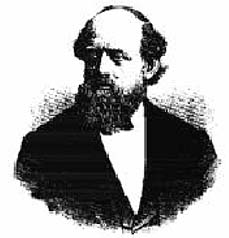 Edward Olney (ALL-nee*) , son of Benjamin Olney and Lucy Emerson, was born in
Moreau, Saratoga County, New York, on July 24, 1827. His ancestry can
be traced back to Thomas Olney who accompanied Roger Williams in
founding the city of Providence and colony of Rhode Island. Benjamin
Olney's family moved to Oakland County, Michigan, in 1833 and, a few
months later, settled on a farm in Weston, Wood County, Ohio.
Edward Olney (ALL-nee*) , son of Benjamin Olney and Lucy Emerson, was born in
Moreau, Saratoga County, New York, on July 24, 1827. His ancestry can
be traced back to Thomas Olney who accompanied Roger Williams in
founding the city of Providence and colony of Rhode Island. Benjamin
Olney's family moved to Oakland County, Michigan, in 1833 and, a few
months later, settled on a farm in Weston, Wood County, Ohio.
Opportunities for formal education on the frontier were sparse, and Olney was largely self-taught. Calloway [2] tells about Edward hiring a neighbor boy to drive the team of oxen on the Olney farm so that he could attend school for six weeks in order to master Day's Algebra. During this time he also ran an arithmetic school at home in the evenings in order to earn the money to pay for his substitute driver.
At age 19, Olney began his career as a teacher in the local elementary schools, while studying mathematics, natural science, and languages on his own. Cajori [1] reports that "though he had never studied Latin, he began teaching it and kept ahead of the class because he 'had more application'." In 1848 Olney was hired as a teacher in the district school at Perrysburg, Ohio. The following year he was named principal of the grammar department in the new Union School. Over the next five years he would become the school's superintendent, marry Miss Sarah Huntington (a teacher at the school), and receive an honorary A. M. degree from Madison University (now Colgate University) in Hamilton, New York. Today there is an Olney School in Lake Township, Wood County, named after him [3].
In 1853 Olney was appointed Professor of Mathematics at Kalamazoo College, Michigan, where he remained for ten years and established the first mathematics curriculum at that institution. He inspired his colleagues and students alike with "his high Christian aims; his generous, self-sacrificing spirit; his thoroughness in government and discipline; and the inspiration which attended him." [2] Although he insisted that his students recite using exact and correct language, he always tried to simplify the explanations of concepts and processes and make them more understandable. Kalamazoo college later conferred the honorary degree, LL. D. upon him.
In 1863 Olney was named Professor of Mathematics at the University of Michigan, succeeding George P. Williams, whose title was then changed to Professor of Physics. In those days the freshmen at Michigan were taught by inexperienced instructors, but once a week they had to recite for Professor Olney. His reputation for being a stern disciplinarian and a stickler for correct details earned him the nickname "Old Toughy." Nevertheless, he took great pains to see that the poorer students obtained help in making up their deficiencies. According to a former student, G. C. Comstock [1], "He was not a harsh man, and although the students stood in awe of him, I think that he was generally liked by them."
While he was at Michigan, Professor Olney began writing a series of successful mathematics textbooks for use in both grammar schools and colleges. In many places these displaced the works of such highly regarded authors as Charles Davies and Elias Loomis. Among the titles are: Elements of Arithmetic for Intermediate, Grammar, and Common Schools (1877), A University Algebra (1873), Elementary Geometry (1883), Elements of Trigonometry (1870), and A General Geometry and Calculus (1871) (online). Olney's treatment of calculus was criticized for using infinitesimal methods, but praised for giving "the elegant method, discovered by Prof. James C. Watson [Professor of Astronomy at Michigan], of demonstrating the rule for differentiating a logarithm without the use of series." [1] It is said that Olney preferred geometry to analysis, and when teaching calculus, he would attempt to translate analytical expressions into their geometrical equivalents. This, along with his own struggles in self-education, contributed to his great success as a teacher and textbook author.
Throughout his career, Professor Olney was a strong supporter of the Baptist churches in Kalamazoo and Ann Arbor. His strong religious convictions led to a concern for his students' personal and spiritual welfare, as well as their mathematical achievements. Edward Olney died on January 16, 1887, after suffering for three years from the effects of a stroke.
Article by David E. Kullman
Miami University
* told to us by people who had attended Olney School